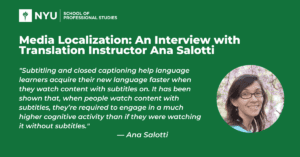Media is everywhere but may not be as accessible as you think. Media localization aims to change that, through the modalities of subtitling and closed captioning. The NYU SPS 6-week hands-on course, Media Localization for Translators: Subtitling And Closed Captioning, teaches students to become skilled translators and interpreters. Students will walk away with an understanding of how to produce industry level closed captioning and subtitles. We talked to the course’s instructor Ana Salotti about what students can expect, and why the field of media localization is important. Salotti is a English and Spanish translator with over 16 years of experience in the industry. She holds a master’s degree in Translation and Interpreting from the University of New South Wales, Sydney, Australia. Read on below for our interview!
What can students expect from the Media Localization for Translators course?
AS: This is a six-week, fast-paced, interactive course, where students will learn the basics of subtitling and closed captioning. They’ll learn some of the theory behind it, such as what subtitles and closed captions are exactly, what the guidelines for creating them are and why those guidelines are important to follow. They will also get a lot of practice. Each week they’ll have a hands-on assignment where they’ll get to apply what they learned during class by creating their own subtitled material, such as a movie or episode clip, or any other type of audiovisual content. They’ll be picking their own video clips from their favorite shows or movies, creating their own subtitles and translating them into their target languages. We will also have a forum where they’ll get to reflect on the weekly topic and engage in lively discussions with their peers and instructor.
How would you define media localization?
AS: I love this question, because I get to use one of the translators’ most frequent answers and clichés: It depends on the context. At some point in their careers, all translators have been or will be asked what the meaning of a word is, and most of them will answer, “It depends on the context. Show me the whole sentence or paragraph. Tell me more.”
The same happens in my answer to your question. Media localization is the term used in and by the entertainment industry, language service industry, and film production and distribution industry to cover a wide range of activities. These activities mainly include subtitling, dubbing, voice-over, video game translation, footage and video adaptation, and theater and script translation. In all media localization activities, there is a transformation of the original audiovisual content. This transformation can be linguistic to a different language and/or visual containing visual changes to the video. The goal in this transformation is to reach to a wider audience which speaks a different language and/or is located in a different region to the ones intended by the original content. The expectation is that this newly transformed media will feel as natural, genuine or “local” as possible to the new audience. That is why the term “localization” is used.
Now if you ask what media localization is among translators or academics who are studying this translation field, they’ll give you more or less the same definition, but will also tell you that they refer to it as “audiovisual translation”. So it’s media localization or audiovisual translation depending on who you’re talking to.
Why are subtitles and closed captioning important?
AS: I think subtitles and closed captions are extremely important for many reasons. They’re an accessibility tool. They make content more accessible not only to linguistic minorities within a country, but also to deaf and hard-of-hearing communities or people with other types of disabilities who need some extra support to understand what is going on the screen. They also democratize visual content because it can now reach a wider audience all around the world.
Subtitling and closed captioning help language learners acquire their new language faster when they watch content with subtitles on. It has been shown that, when people watch content with subtitles, they’re required to engage in a much higher cognitive activity than if they were watching it without subtitles. For this reason, subtitles can help children with learning disabilities, as well as older people with mentally deteriorating conditions.
Lastly, subtitles allow you to watch content even when there’s a lot of background noise around you, like in an airport, plane or at work.
What inspired you to have a career in this field?
AS: Subtitling picked me, rather me picking it as a field of specialization. During my last year of college, I started working in a boutique translation agency specialized in audiovisual translation back in my home country, Argentina. A good friend of mine and colleague was working there, but moved to another country, so her position opened up. She recommended me, and so I started. My task there was to translate TV scripts, and much later subtitles. That was a long time ago. We would work with VHS, transcribing the scripts into our computers while watching and listening to the broadcasted soap opera episodes that were played on an old TV set. Then we would start translating them. It’s crazy to think about how I started and compare it to the way we work with streamed media now.
What do you expect to find most rewarding about teaching this course?
AS: What I find the most rewarding about teaching this course is when a student submits an assignment and says that they spent hours doing it but enjoyed every minute of it. I believe in doing what you love. So, when students learn in my course, but they also have fun and enjoy the activities, the learning becomes much more engrained in your brain and your engagement with what you’re learning skyrockets. That rewards me.
Media Localization for Translators: Subtitling and Closed Captioning starts October 25. Register here.
